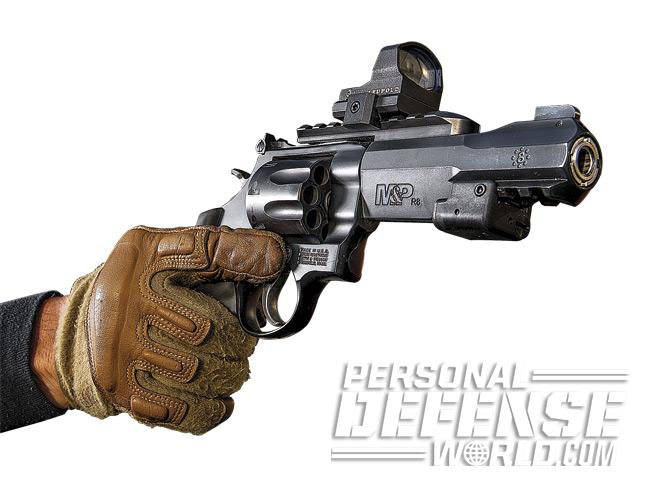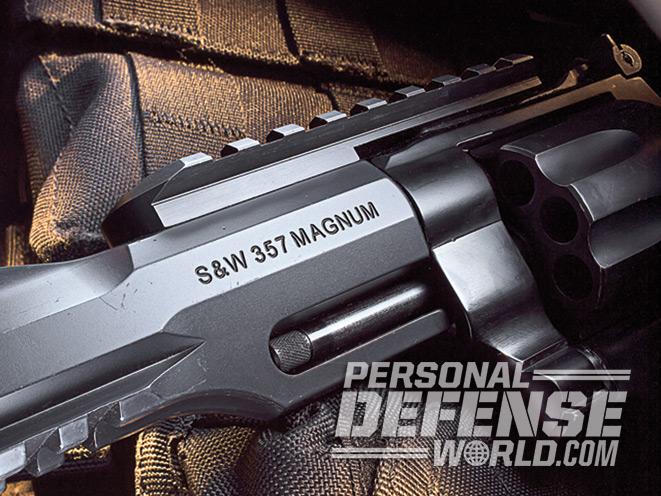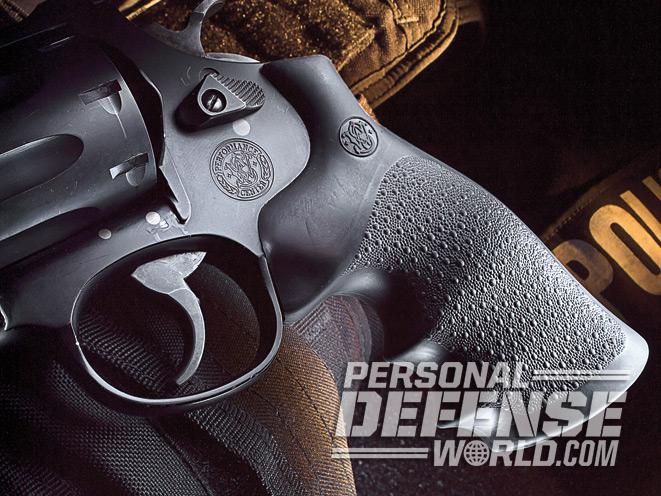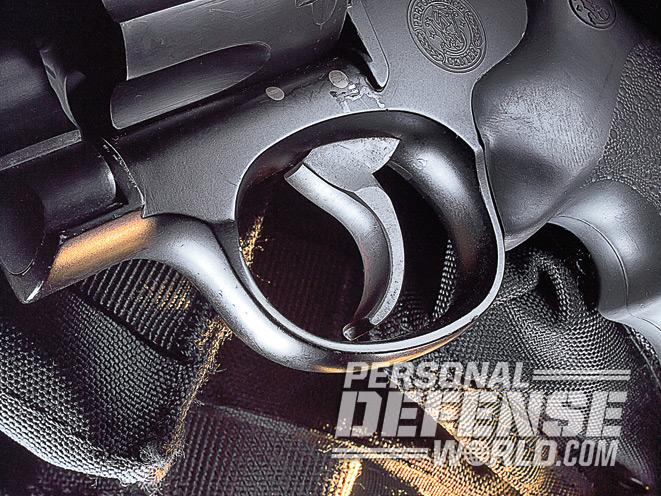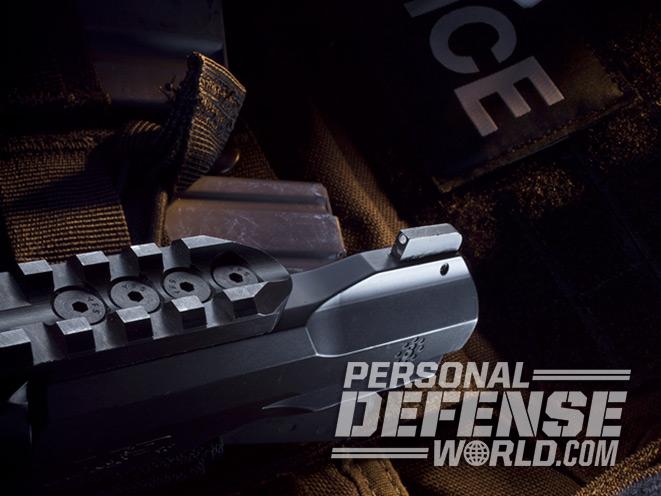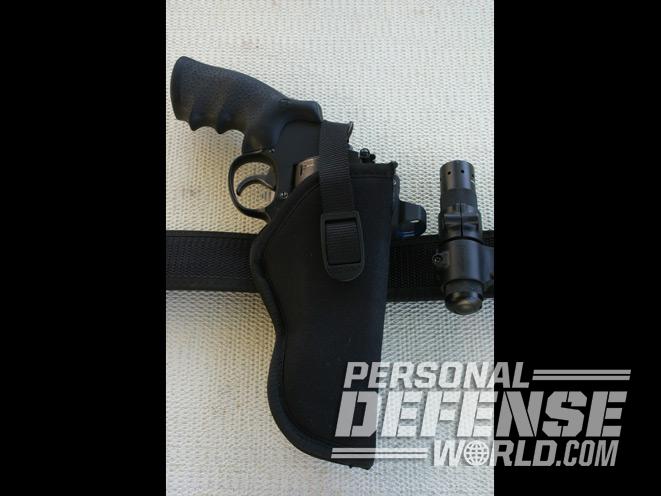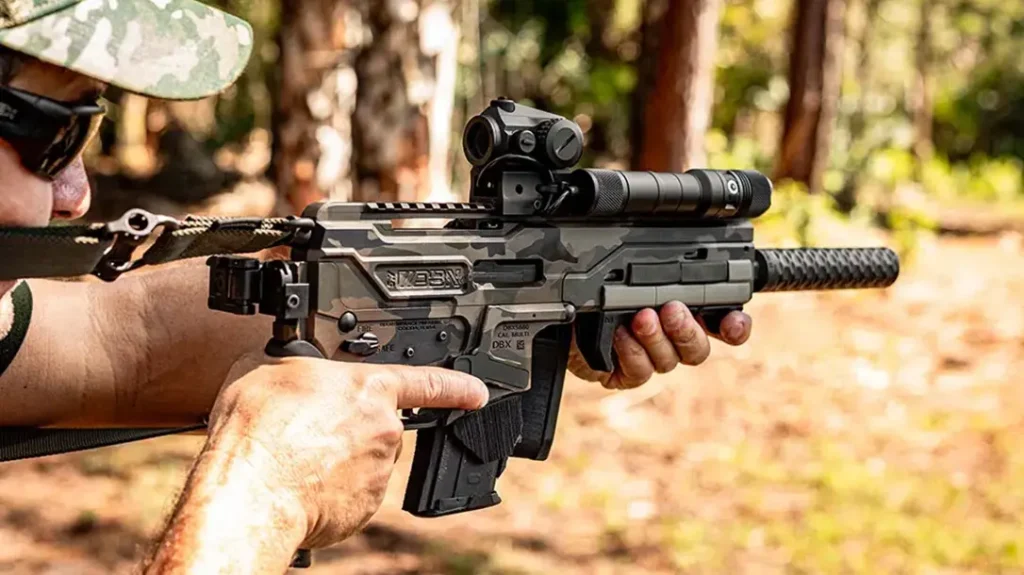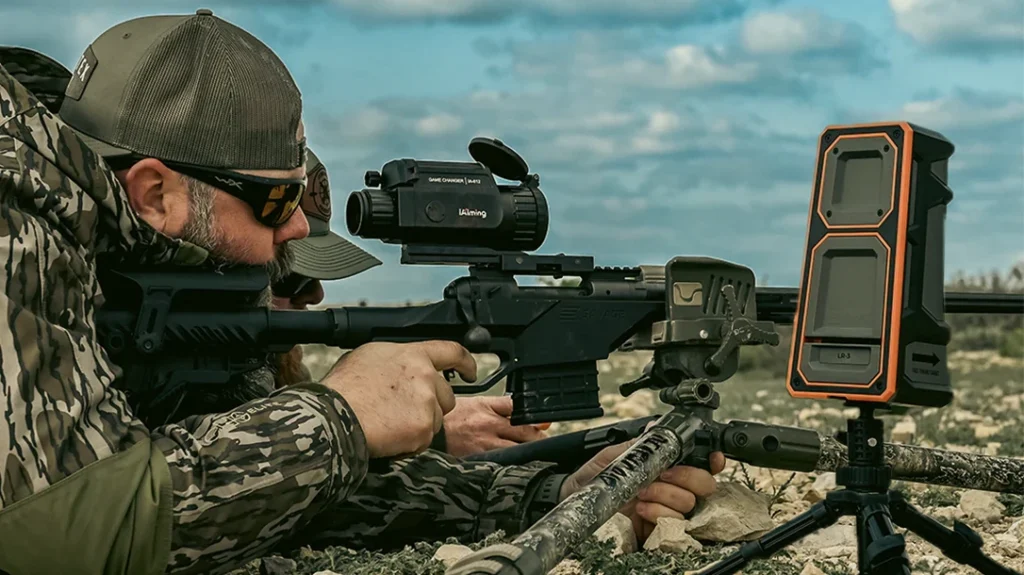While handguns selected for concealed carry are often compact and lightweight, so as to be more comfortable to the wearer and more likely to be carried, the home defense or “house gun” has no such restrictions, unless maybe it’s too big for your bedside table drawer. With this in mind, I recently tested a revolver from Smith & Wesson’s Performance Center, and for those who prefer wheelguns it could just be the ultimate house gun.
Nowadays, we can’t necessarily call a revolver a six-shooter. In fact, this gun is based on S&W’s N-Frame, like those used on the .44 Magnum, and it allows for a larger-diameter cylinder so the company can now make an eight-shot .357 Magnum. Named the Military & Police (M&P) R8, this handgun has a number of unique features.
Next-Gen Wheelgun
Advertisement — Continue Reading Below
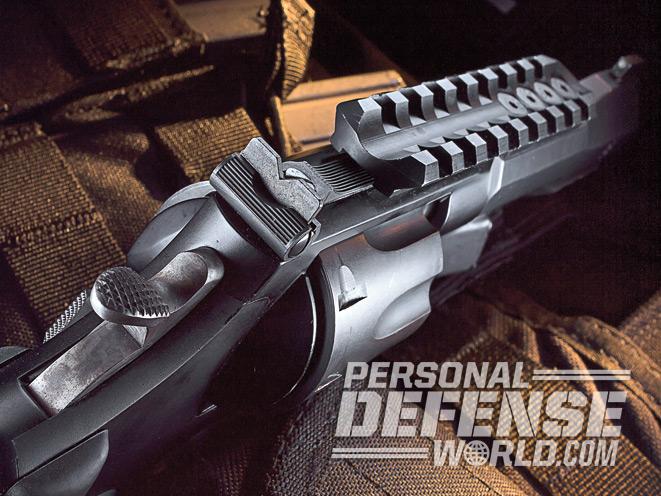
Its standard Picatinny rails are integral with the shroud that fits onto the two-piece barrel system, so you have rails on top and bottom. The steel barrel shroud is held onto the smaller-diameter barrel with a special locking nut at the muzzle, which gives the barrel extra rigidity and more potential accuracy. Almost a throwback to earlier times, the barrel has a length of 5 inches. The shroud also forms the ejector rod underlug, which is also part of the ball-and-detent locking system in conjunction with the cylinder yoke. Up front, on the top side, the shroud becomes a ramp into which an interchangeable front sight is pinned. In this case it’s a 0.125-inch, patridge-style sight with a white dot. Also on the shroud are the special M&P R8 markings and caliber designation. To the rear of the upper rail is a fully adjustable rear sight that has a V-shaped notch, rather than the usual square notch with a white outline.
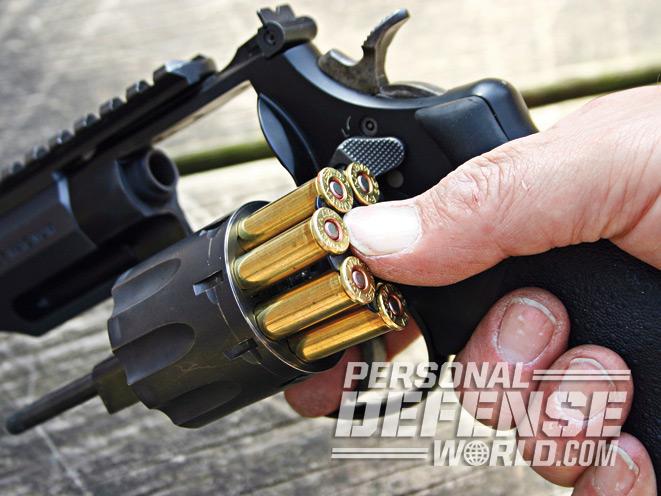
Fashioned from stainless steel, the cylinder, like the rest of the revolver, has a matte black finish. The eight .357 Magnum chambers are chamfered at the rear to assist with the insertion of cartridges; the rear of the cylinder is also counter-bored to allow the use of an eight-round moon clip. To reduce the heft somewhat, the frame of the M&P R8 is made of scandium alloy, limiting the gun to an empty weight of 36.3 ounces. Fitted into the topstrap of the frame, at the rear of the barrel, is a stainless steel shield that prevents hot gases from cutting into the M&P R8 revolver’s frame metal.
RELATED: Smith & Wesson’s New M&P Pistols For 2015 | VIDEO
Advertisement — Continue Reading Below
The grip frame is the universal round-butt K-Frame profile fitted with synthetic-grips with the S&W logo and “pebbled” side panels. Everything else on the M&P R8 is typical of the modern Smith & Wesson revolver. The firing pin is mounted in the frame, the cylinder stop is integral to the frame, there’s a redesigned cylinder-release latch, the inclusion of a keyhole for the internal safety/security lock, plus the extractor star has offset arm tips that keep it locked in place. The hammer has a medium-width spur that’s checkered for a good thumb purchase, and the trigger is wide and smooth-faced, which makes the already smooth Performance Center action feel even smoother.
House-Gun Upgrades
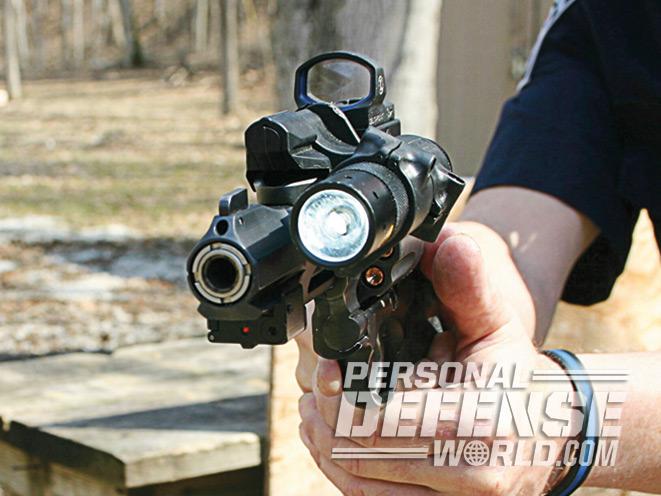
As this is going to be a “house gun” and there are no size, shape or weight constraints, I decided to utilize the accessory rails on the M&P R8 to their fullest.
Advertisement — Continue Reading Below
First, I decided to use a reflex sight added to the upper rail. Few sights offer better features than the DeltaPoint from Leupold. This lightweight red dot, or in this case a 7.5-MOA red triangle, is a true “keep it simple” sighting device. Motion-sensor technology activates the unit so there’s no on/off switch to remember or malfunction, and the red delta is large and easy to see in low light with both eyes open. The DiamondCoat on the sight lens offers abrasion resistance and the ultimate in light transmission, plus my unit came with a variety of bases and pins for multiple mounting applications. The sight’s magnesium housing is finished in matte black and weighs a scant 0.6 ounces. Magnification is 1X and windage and elevation adjustments are both in the 60-MOA range. Adjustments are easily made using the factory-supplied Torx driver and the single CR 2032 3V lithium battery is easy to install or replace. I attached the Leupold DeltaPoint sight on the M&P R8 using the universal Cross Slot Mount and had it sighted in quickly and easily.
RELATED: 8 Smith & Wesson Compact Defenders
As a backup to the DeltaPoint, I mounted a subcompact V3 from LaserLyte on the bottom rail. This is the smallest laser sight offered by LaserLyte, and its tiny, 0.5-ounce, 6061-T6 aluminum housing contains a full 5mw red laser that has both steady and pulse modes. Visible for 500 yards in darkness, the 650nm laser module is powered by 4-377 batteries with a five-hour (steady) and 10-hour (pulse) runtime. Dual on/off buttons in the rear provide versatility and there’s an auto-off feature to help save batteries. The best part is that it will mount on any 1-inch rail with at least 0.75 inches of rail space using its integral claw mount. It was perfect for the M&P R8 and could be attached away from the muzzle yet easily activated. The advantages of a laser to me are the intimidation factor of the red dot and you can focus on the target—and in a low-light situation you can make sure said target is not a “friendly.”
Advertisement — Continue Reading Below
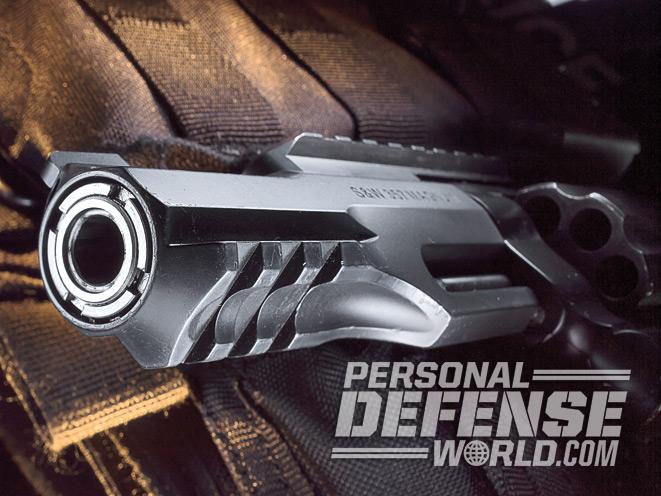
To further assist with target identification and to blind a potential aggressor in a low-light situation, I mounted Safariland’s RLS (Rapid Light System). It’s highly versatile and can be used as a handheld light or a gun-mounted light, plus it has a clip so you can attach it to your belt when you don’t need it. The LED light produces a powerful 190-lumen beam, yet it’s powered by three common AAA alkaline batteries. The rear-mounted, push-button on/off switch is ambidextrous for momentary or steady light activation and can be fitted with a pressure switch tail cap. Made of high-strength aluminum and polymer, the RLS is durable and lightweight. I mounted the light on the upper rail of the M&P R8. The light’s mount pivots on a crane that locks into one of the slots on the rail when it is fully positioned on the left or right side of the gun, and it takes only seconds to attach or remove. Surprisingly, where I put it did not interfere with my use of the Leupold DeltaPoint reflex sight.
I don’t know of any holster that will accommodate the M&P R8 the way I have it set up. As an exercise in curiosity, I did a little experimentation and it occurred to me that a simple and inexpensive Sidekick holster from Uncle Mike’s would work given a little tweaking. I selected a Model #2, the size of which worked well for this N-Frame, 5-inch-barreled revolver. It’s a given that the gun will not fit in the holster with the RLS light attached, but in two seconds the light is off and clipped to the belt near the holster and can be quickly re-attached if needed. I cut a slot in the top of the holster, in front where the rear sight would usually be—this slot allowed me to keep the reflex sight in place on the gun. Next, I cut part of the seam on the back of the holster, near the muzzle. This 1.5-inch cut allowed the gun to be holstered with the LaserLyte laser sight unit in place on the lower rail. As the holster seam is lock-stitched, the remainder of the sewn seam did not unravel. This is not a fast-draw rig, just a means to carry the gun on the belt if need be, and the safety strap on the holster keeps the weapon secure.
Range Work
Advertisement — Continue Reading Below
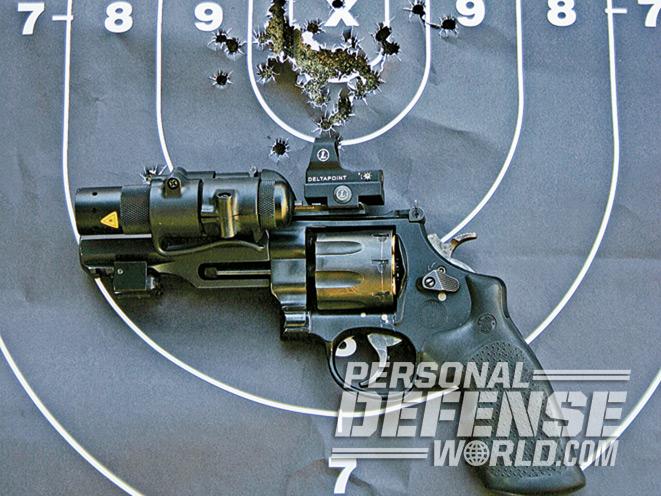
To prove the gun’s functionality I selected three brands of .357 Magnum cartridges, which run the gamut from a high-velocity, lightweight bullet to a more moderate velocity and a heavier bullet design. From CorBon I picked its 125-grain JHP load. Factory specs give it a velocity of 1,450 feet per second (fps), and it’s loaded with a controlled-expansion bullet with a serrated jacket that assures the bullet mushrooms. Next I chose the Starfire load from PMC. This cartridge has a unique 150-grain JHP bullet sporting a deep hollow-point that incorporates a rib and flute design. This gives the nose cavity a “flower petal” appearance and, when combined with the notched jacket, gives this bullet outstanding expansion and penetration characteristics. From Speer I picked a 158-grain Gold Dot HP load. The bullet on this round has an electroplated “jacket” that is punch-formed to give it a cup-like hollow point. The nose of this bullet is notched and serrated to improve its expansion capabilities using the FBI ballistic test protocol.
RELATED: Smith & Wesson’s Next-Gen M&P Shield 9mm
With the gun stripped of its gadgetry, I wanted to see what it would do with just the iron sights, so I put up bullseye targets at the 25-yard mark. Shooting from the bench using a sandbag rest and firing in single-action mode, I triggered three 5-shot groups with each of the test loads. I found the point of aim (POA) needed to be adjusted slightly for each bullet weight: higher for the CorBon and lower for the Gold Dot. I managed to keep everything in the black and my tightest cluster measured 1.33 inches with the Speer load. It also had the best group average, followed in second place by the PMC Starfire. Additionally, I did not use the moon clips during this test phase as they are not mandatory to shoot the R8.
Advertisement — Continue Reading Below
For a practical “home defender” evaluation, I modified a combat qualification course I use in my position as a LE agency firearms instructor. Normally employing 30 rounds, I had to modify it for the eight-round cylinder capacity of the Smith M&P R8, and therefore I ended up using 10 more cartridges than normal. As the CorBon loads were very controllable in rapid fire, I selected them for my practical shooting exercise. A B-27 silhouette target was put up to use as the designated “bad guy.” With the M&P R8 designated as a house gun, none of the scenarios started with the gun in the holster, but with the gun held down and discretely positioned behind the right leg. Rapid reloading was also not really a factor, but a quick reload using the moon clip was done in the first test stage.
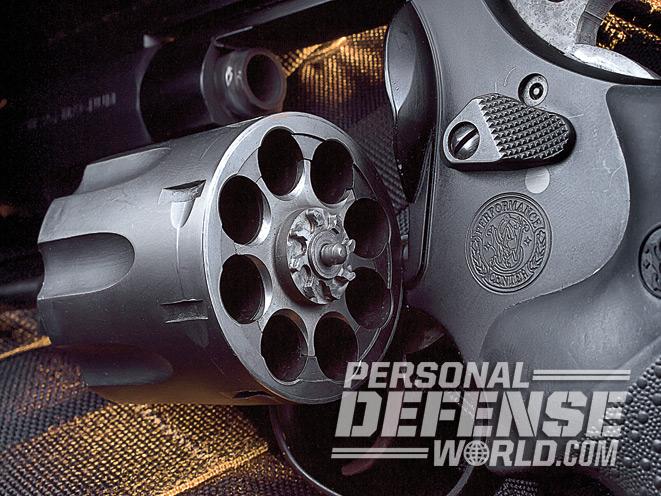
To simulate an up-close-and-personal situation as might occur in a home invasion with intruders attempting to burst through an opened door, I started at the 3-yard line. As the Leupold sight is motion activated, it alone was used in this stage as close distances and a certain amount of surprise precluded the use of the light or laser sight. Using the strong hand only, I took a flash sight picture and fired eight rounds, reloaded with the moon clip and fired eight more with the support hand only. Moving back to 7 yards (or across the room) and having a bit more time to engage the gun’s sighting devices, I activated the LaserLyte laser sight and the Safariland RLS light. It and the Leupold DeltaPoint were used together—looking through the lens of the reflex sight, the laser “dot” was positioned just atop the point of the reflex sight’s projected red triangle. A series of four double-taps emptied the cylinder. After a reload, from the same distance I raised the gun and fired two shots center mass, then one to the head and one to the pelvis of the target; this was then repeated. Moving to cover at 15 yards and reloading, I fired four rounds down low, behind the cover, and four rounds kneeling from behind the cover.
Although a numeric score is mostly unimportant, I did chew a big hole in the center of the target with the M&P R8, sighting accessories and the CorBon cartridges. I also made two good head and pelvis hits in case my “bad guy” was wearing body armor. Why did I shoot 40 rounds? Knowing most home defense deadly force situations are not going to end up like the gunfight at the OK Corral, my purpose was to see if the light, sight and laser would continue to function during all the shooting, and if they would come loose from the various mounting systems.
Advertisement — Continue Reading Below
As it turned out, the reflex sight and laser allowed me to rapidly engage my adversary and do quick follow-up shots without losing my sights. Performing the testing during the day made the tactical light superfluous, but I wanted to make sure it wouldn’t fly off during the shooting or shut down. I also did some dry-fire exercises in the dark stairwell of my house with all three devices on the M&P R8 activated, and nobody was going to get up those stairs if I didn’t let them. The moon-clip system aided fast reloads and the M&P R8, with the added weight of the gadgetry, was easy to control, accurate and no malfunctions of any kind were experienced with gun or gear.
Final Shots
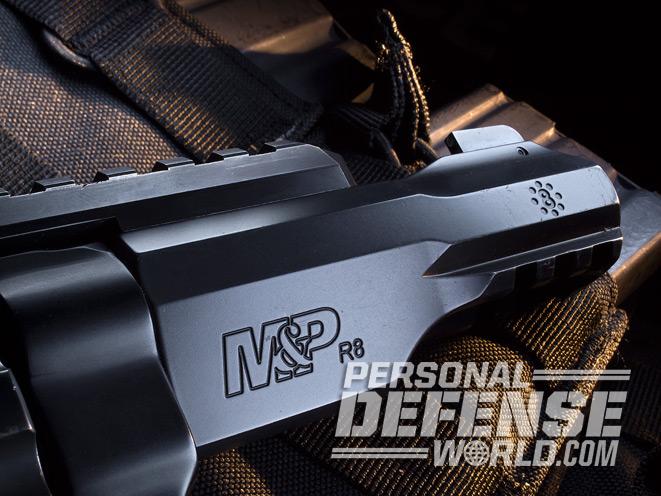
Advertisement — Continue Reading Below
This type of gun and overall setup is not going to be for everyone, especially if you are on a tight budget. What this exercise did allow me to do was see what I could do with the Smith & Wesson M&P R8 and its unique features. By itself it is accurate, rugged and reliable, but with the accessory rails you can now see their potential uses. Not only do the rails make the M&P R8 a formidable house gun, but their versatility can also make this revolver highly competitive for various sporting purposes. Yes, I believe we are now in the age of the autoloader, but the good old wheelgun will never die—this contender from the S&W Performance Center is proof!
Editor’s Note:
We at COMBAT HANDGUNS would like to throw a special shout-out to author William “Bill” Bell, who recently retired from U.S. Customs and Border Protection after 38 years of outstanding service. Along his travels, Bill has found the time to become one of Harris’ most steadfast contributors to CH as well as several other Harris Publications titles, including GUNS OF THE OLD WEST (under the pen name “La Vista” Bill), GUNS & WEAPONS FOR LAW ENFORCEMENT and SPECIAL WEAPONS FOR MILITARY & POLICE. We look forward to having him in our contributor stable for many more years to come. Cheers, Bill!
